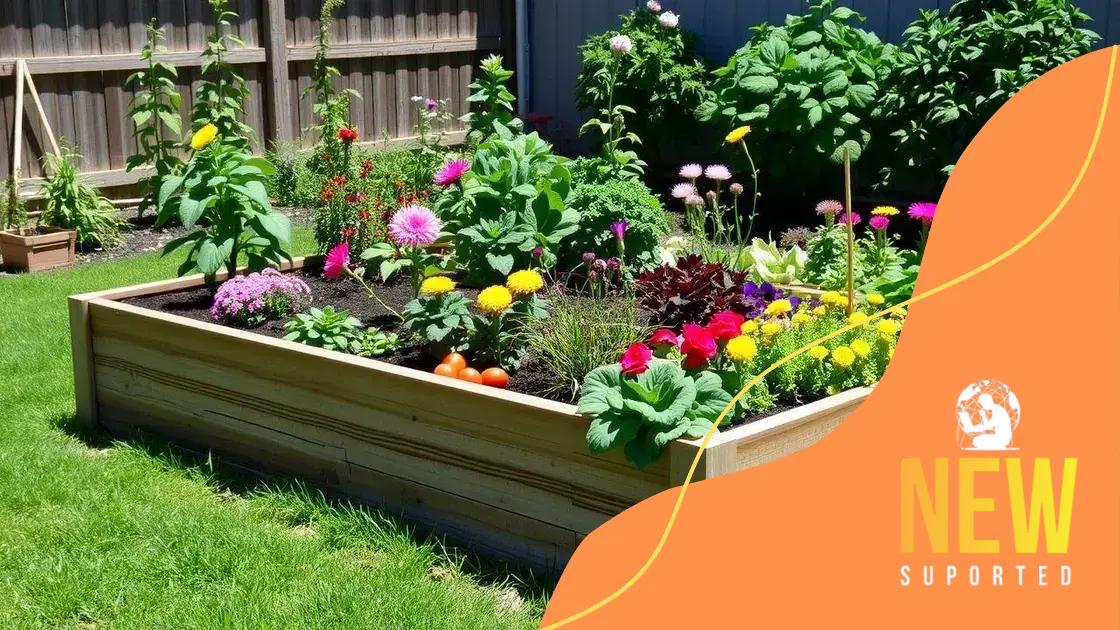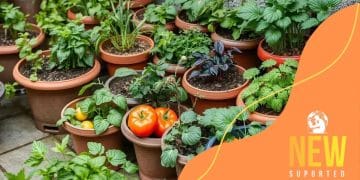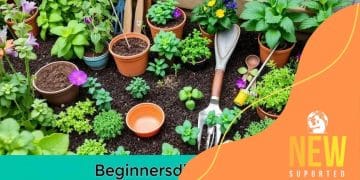How to build your own raised garden beds effectively

To build your own raised garden beds, select quality materials, include well-draining soil, and care for plants through regular watering and pest monitoring to ensure optimal growth.
How to build your own raised garden beds is easier than you might think. Have you ever wanted to grow your own vegetables but lacked the space? Raised beds are a fantastic solution that can fit in small yards or even on patios.
Choosing the right location for your garden bed
Choosing the right location for your garden bed is essential for ensuring your plants thrive. The placement of your raised garden bed can significantly impact the growth, health, and yield of your crops.
Firstly, you’ll want to consider sun exposure. Most vegetables prefer at least 6 to 8 hours of sunlight daily. Look for an area in your yard that does not have large trees or structures blocking the sun. If you’re unsure, observe sunlight patterns throughout the day to find the ideal spot.
Understanding Wind and Water Flow
Along with sunlight, it’s crucial to analyze the wind patterns in your garden area. Strong winds can damage delicate plants, so choose a location that offers some protection, like near a fence or shrubbery. Additionally, consider how water flows in your yard when it rains. Place your garden bed in a spot that avoids standing water, which can lead to root rot and other moisture-related problems.
Access and Maintenance
Accessibility is another key factor. You’ll want to have easy access to your garden for planting, watering, and harvesting. Ensure there’s enough space around your raised bed for movement and maintenance. Raised beds should be at a comfortable height for you to tend to, saving you from bending down too much.
- Choose areas with ample sunlight.
- Consider wind protection and water drainage.
- Ensure you have easy access for maintenance.
Finally, think about the distance from your home. Being close to your kitchen or living area can make it easier to monitor your plants and incorporate freshly harvested veggies into your meals. If you’re new to gardening, start with a smaller bed in a visible area so you can easily keep an eye on it!
Essential materials for building raised beds
When it comes to constructing your raised garden beds, selecting the right materials is crucial for their durability and effectiveness. Using high-quality materials ensures that your garden beds will last for years and support healthy plant growth.
To start, you will need wood for the frame. Cedar or redwood are excellent choices because they resist rot and insects. If these options are out of your budget, treated pine can also work but be cautious of chemicals used in the treatment. Make sure that any wood you choose is safe for growing edible plants.
Container and Soil Options
In addition to wood, consider the soil you will fill your raised bed with. A good mixture typically includes a combination of topsoil, compost, and a soilless growing medium. This blend provides nutrients and excellent drainage for your plants.
Essential Tools
You will also need some important tools to make the building process easier. Having the right equipment can save time and strengthen your design. Essential tools include:
- A saw for cutting wood to size.
- A drill for fastening your bed together.
- Measuring tape to ensure accurate dimensions.
Finally, don’t forget about landscaping fabric or a weed barrier to prevent unwanted weeds. Placing this at the bottom of your raised bed will keep weeds at bay while allowing for proper drainage.
Choosing the right materials not only equips your garden bed for success but makes the gardening process more enjoyable. With the right setup, you can look forward to a bountiful harvest season after season!
Step-by-step guide to constructing garden beds

Building your own raised garden beds can be a rewarding project. This step-by-step guide will help you create sturdy and functional beds that will serve your garden well for years.
Start by gathering your materials. You will need the wood you chose, screws, and tools like a saw and a drill. Measure the area where you want the bed to sit. A standard size is about 4 feet wide and 6 to 8 feet long. This makes it easy to reach across without stepping into the bed.
Cutting the Wood
After measuring, mark the wood where you need to cut. Use a saw to cut the wood to the desired lengths. Be sure to wear safety gear while cutting. Once you have your pieces, you should have four sides: two long pieces and two shorter ones.
Assembling the Frame
Next, it’s time to assemble the frame. Lay the pieces on a flat surface. Connect the short sides to the long sides, forming a rectangle. Use screws to join each corner securely.
- Make pilot holes first to prevent the wood from splitting.
- Ensure the frame is square by measuring the diagonals.
- Tighten all screws to make the structure sturdy.
After assembling the frame, consider adding corner supports for extra stability. These can be additional pieces of wood installed inside each corner.
Now, it’s time to place your garden bed in the chosen location. Level the ground underneath it, so it sits evenly. If necessary, you can use shims to adjust the height on uneven terrain.
Filling the Bed
Once the bed is in place, it’s ready to be filled. Start with a weed barrier at the bottom to prevent weeds. Next, layer in a mix of topsoil, compost, and other organic materials. This ensures that your plants have the nutrients they need to grow.
Water the soil lightly to help it settle, and your raised bed is ready for planting!
Best plants for raised garden beds
Choosing the right plants for your raised garden beds can make a significant difference in your gardening success. With their controlled environment, raised beds can be perfect for a variety of crops that thrive in these conditions.
Some of the best plants for raised gardens include vegetables, herbs, and even some flowers. For optimal yields, consider planting crops that have similar watering and light requirements to help manage your watering schedule. Let’s explore some of the top choices.
Vegetables
Raised garden beds are ideal for growing vegetables due to excellent drainage and soil quality. Some popular options are:
- Tomatoes – They love sunlight and well-draining soil.
- Peppers – Both sweet and hot varieties do well in raised beds.
- Lettuce – Grows quickly and can be harvested multiple times.
These vegetables are not only productive but also relatively easy to care for, making them great choices for beginners.
Herbs
Herbs can thrive in raised beds, bringing flavor to your cooking and fragrance to your garden. Consider growing:
- Basil – Perfect for summer dishes and pairs well with tomatoes.
- Mint – A vigorous grower, best planted in its own corner.
- Thyme – Drought-resistant and aromatic, it’s easy to maintain.
Growing herbs in a raised bed can lead to a bountiful supply right at your fingertips when cooking!
Flowers
Incorporating flowers into your raised garden can attract pollinators and add beauty. Consider marigolds or nasturtiums, which are both edible and beneficial for your vegetable garden.
Choosing the right plants will ensure that your raised garden thrives and provides a bounty of fresh produce and colorful blooms. Experiment with different varieties to find the best combinations that suit your taste and gardening style!
Maintaining your raised garden for optimal growth
Maintaining your raised garden is key to achieving optimal growth and a bountiful harvest. Proper care involves regular monitoring, watering, and nutrient management to keep your plants healthy and productive.
One of the first aspects to consider is watering. Raised beds tend to drain quickly, so consistent moisture is vital. It’s advisable to check the soil about two inches below the surface. If it feels dry, it’s time to water. Deep watering encourages roots to grow deeper, enhancing drought resistance.
Monitoring Plant Health
While tending to your garden, keep an eye on your plants for signs of pests or diseases. Catching problems early can prevent larger issues. Look for:
- Discoloration – Yellowing leaves may indicate nutrient deficiency or pests.
- Wilting – This can suggest inadequate water or root issues.
- Small holes in leaves indicate insect activity.
If you notice any of these signs, take action promptly. For example, you might need to adjust your watering routine or apply organic pest control methods.
Caring for Soil Nutrients
Healthy soil is the foundation of a successful raised garden. It’s beneficial to replenish nutrients throughout the growing season. Adding compost or organic fertilizers will provide essential nutrients to your plants. Apply compost every few weeks to enrich the soil without chemical additives.
Also, consider rotating your crops each season. This practice helps manage soil nutrients and can reduce pest issues by disrupting their life cycles. Try planting a different type of plant in each bed annually for the best results.
Regular maintenance of your raised garden bed, including proper watering, pest monitoring, and soil management, is fundamental for a thriving garden. By following these steps, you can enjoy a productive gardening experience all season long.
FAQ – Frequently Asked Questions About Maintaining Your Raised Garden
How often should I water my raised garden beds?
You should check the soil moisture regularly and water your raised garden beds whenever the top two inches of soil feel dry. It’s important to keep the soil consistently moist.
What signs indicate my plants are unhealthy?
Look for yellowing leaves, wilting, or holes in leaves. These can be signs of nutrient deficiencies, insufficient water, or pest issues.
Why should I add compost to my raised beds?
Adding compost replenishes nutrients in the soil, supports healthy plant growth, and improves soil structure.
Is it necessary to rotate crops in my raised garden?
Yes, rotating crops helps to maintain soil health, prevents soil depletion, and reduces pest and disease buildup.






